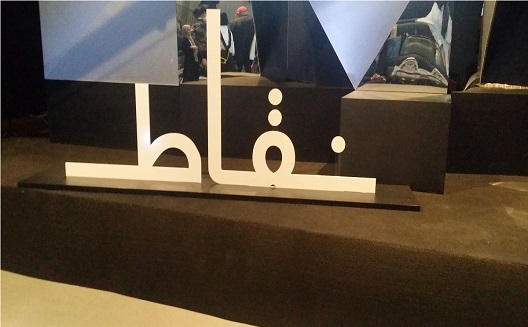Nuqat’s Copy+Paste Syndrome discusses imitation and innovation

This article is a crosspot with Nuwait.
Are there any original ideas? Is imitating another idea a good thing? Does copying ideas encourage innovation, or does it stifle it?
These questions were the center of Nuqat’s sixth annual conference, Copy+Paste Syndrome, held from November 12 to 18 at Dar al-Athar al-Islamiyyah (DAI) in Kuwait.

Coffee breaks and networking in-between workshops. (Images via
Sara Tarik)
Thirty-five speakers and lecturers delivered seminars on the role of arts and innovation in entrepreneurship, launching businesses in art and others. French Ambassador in Kuwait Christian Nakhlé kicked off the event with a word on how copy-pasting is not necessarily theft or fraud, but the addition of a positive touch.
Copy, Paste, Innovate
Nuqat has certainly come a long way since its first conference in 2009.
 “We
made sure that the events of this year are more diverse and
interactive, whether in workshops or lectures done in local and
regional partnerships, like Art Jameel Photography, Azza Fahmy
Jewellery and Aramco,” said Nuqat’s founding member
Wakim Zeidan, (right).
“We
made sure that the events of this year are more diverse and
interactive, whether in workshops or lectures done in local and
regional partnerships, like Art Jameel Photography, Azza Fahmy
Jewellery and Aramco,” said Nuqat’s founding member
Wakim Zeidan, (right).
“From the entertainment side, we held a number of cultural, musical
and artistic events and evenings, in collaboration with local and
regional entities so that Nuqat can offer a comprehensive cultural
program.”
The most popular workshops of the conference were the
Creative Entrepreneurship: From Creative to Customer, according to
Zeidan, which was hosted by Jason Steel and Sarah Thelwal, as well
as the Innovative Entrepreneurship: A Creative Process session
offered by Amar Behbahani.
Speaking of copying and pasting ideas, perhaps Lynn Sader is a good
example of how it’s not always a negative thing.
As an entrepreneur, Sader used the “Miswak”, a traditional and
natural teeth cleaning tool used as a toothbrush, and an important
part of the Arab heritage, and offered it as a modern product under
the name This Miswak. She
adorned it with modern packaging while promoting its health
benefits and cultural value to target both today’s consumers in the
west and the Arab World.
Pros and cons
Architect Waleed Al Shalaan spoke of the negative influence that
copy pasting has on design, where many designers copy different
elements and ideas from other designers, producing a misshapen copy
of the original. In the long run, imitation limits innovation and
creativity of designers, and makes them dependent on blind copying,
he added.
Instead, Al Shalaan advised entrepreneurs to pay close attention to
the quality of their products, as this is the criterium that
attracts long term customers. He gave Apple as an example. The
company, which sells its products at a price higher than its
competitors, take extra care of the details of its product design,
like the shape, color and packaging, creating an emotional bond
between the user and product, consequently guaranteeing consumer
loyalty. “A copycat may enjoy brief success, but quality remains
the best criteria for long term success,” Al Shaalan concluded.
What about the positive side?
Wajha, an initiative
by Hussein Alazaat and Ali Almasri, is a positive example of
copying.
Alazaat and Almasri conducted a workshop on Social Design. Wajha is an initiative that aims to rejuvenate the neglected fronts of small shops in poor areas through several local methods and techniques.
“We have created a design to be copied,” said Alazaat, adding that now copying is a better phenomenon. “We were able to spread the culture of design more, and thus merge between design and social entrepreneurship in one mold.”

More coffee and networking.
Copying in teaching
The educational methodologies and curriculums are considered one of the main barriers to Arab creativity. On this topic, Nuwait spoke with Laura Boushnak, a Palestinian photographer who focused on education for her her 2009 project “I Read I Write”.
“Concentrating on memorizing instead of understanding concepts, through a set of old techniques that focus on the memory of the students instead of their perception, is the reason behind many of our educational problems,” Boushnak said.
The solution, she continued, “lies in re-focusing on neglected subjects like drawing and music as well as developing a love for reading among students, to compensate for their lack of practical talents.”
Yasmine Taan, chairwoman of the department of design at the Lebanese American University (LAU), said that spreading awareness on the importance of design is the teachers’ responsibility.

Time for some music, and coffee.
Nuqat 2015: more interaction
Despite being relatively small, entrepreneurship in Kuwait has nevertheless developed greatly in the last few years. In a talk with Azza Fahmy, Egyptian jewelry designer who reached international recognition, the designer told Nuwait that she had closely followed the development of Nuqat since its development in 2009 until now. “I noticed the level of maturity that it has gained year by year, until it has grown to be a venue for discussing the most important cultural and intellectual issues.”
Indeed, the Nuqat team holds high hopes for a better future. In the next event, “we will offer a yearly cultural program divided into monthly events that target two audiences: children aged 4 to 12, where we work on developing their creativity and innovation and the second audience are aspiring creators from different fields who want to be entrepreneurs.”
Zeidan believes that Nuqat’s program will help these participants develop their skills in entrepreneurship to create a creative economy based on innovative industries in various field, like design and the arts and others.
Copying alone is perhaps not enough, but copying while adding a unique local touch is what makes an idea innovative. French ambassador Nakhlé concluded his talk saying that modern and ancient history teach us that copying smartly leads to huge progress in research, and the work of scientists and innovators throughout history proves it.


